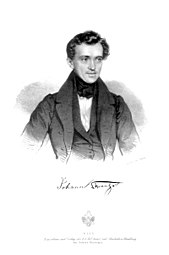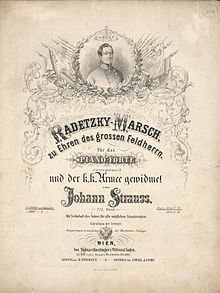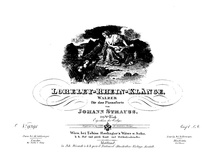Johann Strauss (father)

Johann Baptist Strauss (also Johann Strauss ; born March 14, 1804 in Leopoldstadt , today Vienna ; † September 25, 1849 in Vienna) was an Austrian composer and conductor . In order to avoid confusion with his son of the same name , he is usually called Johann Strauss father (or Johann Strauss (father) , in the English-speaking area also Johann Strauss I ). His best-known work to this day is the Radetzky March , premiered in 1848 , with which, in an arrangement byLeopold Weninger , traditionally closes the New Year's Concert of the Vienna Philharmonic .
Although the name "Strauss" can usually be found with " ß " in reference works , Strauss himself wrote his name in cursive "Strauſs", with a double sign - not " long s " - before the s.
Life
Johann Strauss was the son of the landlord Franz Borgias Strauss (October 10, 1764 - April 5, 1816) and appeared in the bar very early on. In 1817 he began an apprenticeship as a bookbinder and also passed the journeyman's examination. In 1824 he was drafted into the high and German masters , the Vienna House Regiment; there he was also active as a musician.
He received violin lessons from Michael Pamer and Johann Pollischanzki , and from 1830 he learned music theory from Ignaz von Seyfried . From 1823 Strauss played together with Josef Lanner and the Drahanek brothers, but he also worked as a substitute musician in other orchestras.
On April 4, 1824 he made his first public appearance as a composer. In 1827 he was able to found his own company. He performed in various bars - including " Zum Sperl " - in Vienna's Leopoldstadt , became head of the band of the 1st Citizens Regiment in 1832 and, in 1835, court ball music director at the Imperial Court. He founded the first travel orchestra in the world: several months of concert tours with his now larger orchestra led to all major German cities as well as France and Great Britain.

In 1834 he moved into the so-called Hirschenhaus ( to the golden hirschen ) in Leopoldstadt, Taborstrasse 17, which is no longer in existence today and is adjacent to the “Sperl” , where he rented four apartments for himself and his family, including one that was only intended for his work .
Johann Strauss was married to the landlord's daughter (Maria) Anna Streim (1801–1870), but left his family and then lived in a relationship with the milliner Emilie Trampusch (1814 - after 1865), with whom he had eight children. His three surviving sons of Anna - Johann , Josef and Eduard - also became musicians. His son Johann became a serious competitor of his father from 1844 - massively supported by his mother against his father's will.
Joseph Lanner, the colleague and competitor of Strauss' father, died in 1843. In 1849 Strauss died of scarlet fever in Emilie Trampusch's apartment in Kumpfgasse (now the 1st district) . He was buried in the old, later abandoned Döblinger cemetery . On June 11, 1904, he and Lanner were exhumed there and on June 13, 1904, they were buried next to each other in graves of honor at the Vienna Central Cemetery (Group 32 A, No. 15, Lanner: No. 16). Their old gravestones were included in the design of the Strauss-Lanner Park , which opened in 1928 in place of the cemetery .
In 1905 the Strauss-Lanner monument was erected in Vienna's Rathauspark , on which the two composers stand next to each other in Biedermeier tailcoats . The complex was designed by the architect Robert Oerley , the metal figures were designed by the sculptor Franz Seifert . Anna-Strauss-Platz was named after Strauss' abandoned wife, the mother of the "Waltz King", in 2006 in Hietzing , Vienna's 13th district since 1892 , not far from Dommayers Casino , where Strauss' father, Josef Lanner and Strauss' son often performed were. Since 1961, together with the German composer Richard Strauss (1864–1949), he has given its name to Mount Strauss on Alexander I Island in Antarctica.
In 1951, Wien tanzt, a free film biography, was published in which Strauss is portrayed by Adolf Wohlbrück . This has little to do with the actual state of research that was already known at the time.
Works
Johann Strauss' father wrote 152 waltzes , 32 quadrilles , 13 polkas and 18 marches . His best-known work is the Radetzky March , and his most successful Viennese waltz is the Loreley Rhine Sounds .
The Vienna Library in the City Hall offers digital copies of 86 of his works.

Marches (selection)

- Radetzky March op.228 (1848)
- Jelačić March op.244
Quadrilles (selection)
- Cheers Quadrille op. 130
- Louisen Quadrille op.234
Polkas (selection)
- Sigh Galop Op. 9
- Chinese Galop Op. 20
- Feeder Gallop Op. 35
- Sperl-Galopp op. 42
- Fortuna Gallop op.69
- Travel gallop op. 85
- Ball Night Gallop op.86
- Youth Fire Gallop Op. 90
- Cachucha Gallop Op. 97
- Indian gallop op.111
- Sperl-Polka op.133
- Popular Annen-Polka op.137
- Salon Polka op.161
- Eisele and Beisele jumps op. 202
- Kathinka Polka, Op. 218
- Viennese cruiser polka op.220
- Piefke and Pufke Polka op.235
- Alice-Polka op.238
- Ladies souvenir polka op.236
- Exeter Polka op.249
Waltz (selection)

- Täuberln Waltz op.1 (1826)
- Döblinger Reunion Waltz op.2 (1826)
- Vienna Carneval op. 3 (1827)
- Chain Bridge Waltz op.4 (1827)
- Society Waltz op.5 (1827)
- Viennese mood waltz op.6 (1817)
- Charmant Waltz op.31 (1829)
- Benifice Waltz op.33 (1830)
- Good opinion for the lust for dance op.34 (1830)
- Tivoli-Rutsch Waltz op.39 (1830)
- Vive la Danse! op. 47 (1831)
- Cheerful even in serious times op.48 (1831)
- Life a dance or The dance a life! op. 49 (1832)
- Bajaderen Waltz op.53
- My most beautiful day in Baden op.58 (1835)
- Gabrielen Waltz op.68
- Elisabethen Waltz op.71
- Pink Waltz op.76 (1836)
- Second waltz garland op.77 (1835)
- Homage waltz op.80 (1836)
- Philomelic Waltz op.82 (1835)
- Brussels lace op.95 (1837)
- Ball-Racketen op.96 (1837)
- Paris Waltz op. 101 from 1838, it contains a three-quarter time version of the Marseillaise in the coda
- Greetings ... op.105 (1839)
- Vienna Gemüths Waltz op.116 (1840)
- Cäcilien-Waltz op.120 (1839)
- Apollo Waltz op.128 (1839)
- Adelaiden Waltz op.129 (1841)
- Egerien Waltz op.134 (1842)
- Loreley-Rhein-Klänge op.154 (1843)
- Secret from the Viennese Dance World op.176 (1845)
- Heart sound waltz op.203
- Helenen Waltz op.204 (1848)
- State Color Waltz op.232
- The Messengers of Peace op. 241
See also
- Strauss (family)
- Museum of the Johann Strauss Dynasty Vienna; using original documents, engravings and photographs, it shows the story of Johann Strauss' father and his sons Johann, Josef and Eduard Strauss.
literature
- Constantin von Wurzbach : Strauss, Johann I father . In: Biographisches Lexikon des Kaiserthums Oesterreich . 39th part. Kaiserlich-Königliche Hof- und Staatsdruckerei, Vienna 1879, pp. 327–344 ( digitized version ).
- Eusebius Mandyczewski : Johann Strauss (father) . In: Allgemeine Deutsche Biographie (ADB). Volume 36, Duncker & Humblot, Leipzig 1893, pp. 548-550.
- Hans Werner Bousska: Take me out. out to the Tivoli zum Strauss ... Johann Strauss (father) and the Tivoli in Meidling (= sheets of the Meidlinger District Museum. Issue 48). Vienna 1999.
- Frank Miller (d. I. Helmut Reichenauer ): Johann Strauss father - the musical magician of the Viennese Biedermeier. Documentary biography. Castell, Eisenburg (d. I. Vasvár) 1999, ISBN 3-9501095-0-1 .
- Strauss Johann. In: Austrian Biographical Lexicon 1815–1950 (ÖBL). Volume 13, Verlag der Österreichischen Akademie der Wissenschaften, Vienna 2007–2010,ISBN 978-3-7001-6963-5, p. 377 f. (Direct links on p. 377 , p. 378 ).
- Strauss, Johann. In: New German Biography (NDB). Volume 25, Duncker & Humblot, Berlin 2013,ISBN 978-3-428-11206-7, p. 497 f. ( Digitized version ).
Web links
- Entry on Johann Strauss (father) in the Austria Forum (in the AEIOU Austria Lexicon )
- Works by and about Johann Strauss in the catalog of the German National Library
- Works by and about Johann Strauss in the German Digital Library
- Sheet music and audio files by Johann Strauss (father) in the International Music Score Library Project
- Original manuscripts by Johann Strauss (father) in the Vienna library
- Strauss, Johann I Vater: List of available sheet music (used to supplement the catalog raisonné) Musikverlag Doblinger
- www.johann-strauss.at
Remarks
- ^ Eduard Strauss: Strauss / Strauẞ. In: https://www.johann-strauss.at . Vienna Institute for Strauss Research, accessed on December 30, 2019 .
- ↑ Franz Borgias Strauss , ancestral index
- ↑ Michael Lorenz : Family Trampusch - loved and hushed up. In: Yearbook of the Association for the History of the City of Vienna , Volume 62/63 (2006/2007), Vienna 2011, pp. 135 ff.
- ↑ Fremd-Blatt, Vienna, No. 162, from June 12, 1904.
- ↑ Foreigners-Blatt, Vienna, No. 163, of June 13, 1904.
- ↑ Vienna Digital Library: 86 music manuscripts by Johann Strauss (father)
| personal data | |
|---|---|
| SURNAME | Strauss, Johann |
| ALTERNATIVE NAMES | Strauss, Johann Baptist; Strauss, Johann Baptist |
| BRIEF DESCRIPTION | Austrian composer and conductor |
| DATE OF BIRTH | March 14, 1804 |
| PLACE OF BIRTH | Leopoldstadt (district of Vienna) |
| DATE OF DEATH | September 25, 1849 |
| Place of death | Vienna |
